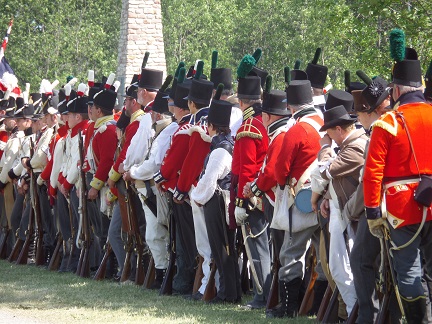

 |

|
|
July 5, 1814 Once again the Americans were invading Canada, but this time there were not stopped by the British, but through the inability to supply the advance. Unlike the Ft. George fiasco of 2013, steps were quickly taken to use the advantage gained by the capture of Ft. Erie. Gen. Riall had already sent reinforcements to Ft. Erie when they learned it was captured and the troops stopped at Chippewa. Scott was sent toward Chippewa with his brigade, accompanied by Captain Towson's artillery, on the morning of the 4th to attack the British relief force. Scott marched along the Canada shore of the Niagara River where he met a considerable British force under Lt. Col. Pearson, and, after a sharp skirmish, he drove them off. Jesup, in command of the 25th regiment described the march as "a continual skirmish." The skirmish intensified once the Americans arrived at Chippawa. Believing Scott's troops to be only "Buffalo militia," the British held their ground, expecting the Americans to break. Finding the enemy strongly entrenched; Gen. Scott took a position behind Street's Creek, where he encamped for the night. At about midnight the main body of Brown's army came up. At about noon on the 5th Scott was joined by 300 Pennsylvania militia and about 400 Native Americans under Capt. Pollard and Red Jacket. The British were reinforced during the night by the 8th, or King's Regiment, from York. For several hours both forces sent out pickets and scouts, occasionally exchanging fire. Finally the American pickets on the extreme left of Scott's line became so annoyed by a heavy body of British light troops and Native Americans in the woods, that at 4PM troops were sent to dislodge them. After driving the pickets off, the Americans found themselves within a few yards of the entire British force advancing in line abreast. British Attack The British plan was to Attack the American camp with his whole force, and immediately ran into Porter. Gen. Brown was on the extreme left, watching Porter at this time and correctly noted the British to be advancing, and dispatched Gen. Ripley with the 21st Regiment as reinforcements. He also ordered Gen. Scott to cross Street's Creek at once with his whole brigade and Towson's artillery to meet the British line. Gen. Riall's advancing army was composed mainly of the 100th Regiment, commanded by the Marquis of Tweeddale; the 1st under Lt. Col. Gordon; a portion of the 8th Regiment, under Maj. Evans, some artillery, dragoons, militia and a body of Native Americans. Scott crossed Street's Creek over the bridge and the 9th, part of the 22nd Regiment, 11th and the 25th Regiment came under artillery fire from the British batteries. Towson's artillery, placed near the bridge, was able to keep the British at bay. Scott's troops moved up as Porter's fell back, leaving only Porter, his staff and a small number of volunteers on that side of the field. The then fire intensified along the entire line of both armies. As the British maneuvered Scott actually order a bayonet charge by the 11th. A similar charge was made by Leavenworth and Towson's battery blew up an ammunition-wagon causing great confusion along the British line. Jesup then ordered his soldiers to "support arms and advance" and was able to drive off some of the British troops who withdrew to the other side of Chippewa Creek. The American loss during the morning skirmishing and in the evening battle was 61 killed, 255 wounded, and 19 missing. The British lost 236 killed, 322 wounded, and 46 missing. The British then tore up Chippewa Bridge and the two armies occupied the same relative position which they did at dawn. Aftermath Although the battle was not decisive, it was clearly won by the Americans the first time on the Niagara front that the follow up battle after A US crossing was won by American troops. The Native Americans allies of the British were disheartened. Their disaffection, begun at the Thames, continued in increasing numbers. Nearly all left the British army and returned to their homes. The biggest result of the victory was increased enlistments in the US. Gen. Brown was impatient to advance, expecting the arrival of Chauncey at the mouth of the Niagara River to cooperate with the advance. Early on the morning of the 7th, Gen. Brown went out to explore a logging road and found it passable, using it to bypass the British positions north of the Chippewa. Riall discovered Brown's movement, and withdrew with the whole army to Queenston. US forces rebuilt the bridge and pursued the retreating British. Brown waited at Queenston for the arrival of Chauncey, unable to obtain supplies from the Genesee River or Sodus supply depot without the fleet. The 10th of July was appointed for the fleet's arrival. Word soon came that Chauncey was sick, and his fleet blockaded in Sackett's Harbor. Expected reinforcements were also trapped in the port. Riall in the meantime had marched with 1,500 men for Burlington Heights, leaving soldiers of the 41st and 8th Regiments, and seamen and marines from two of Yeo's vessels in the Niagara River, to garrison the forts. Riall was reinforced at Burlington with the 103rd, and some companies of the 104th Regiment on the way. He turned back and took position at Fifteen-mile Creek.
|